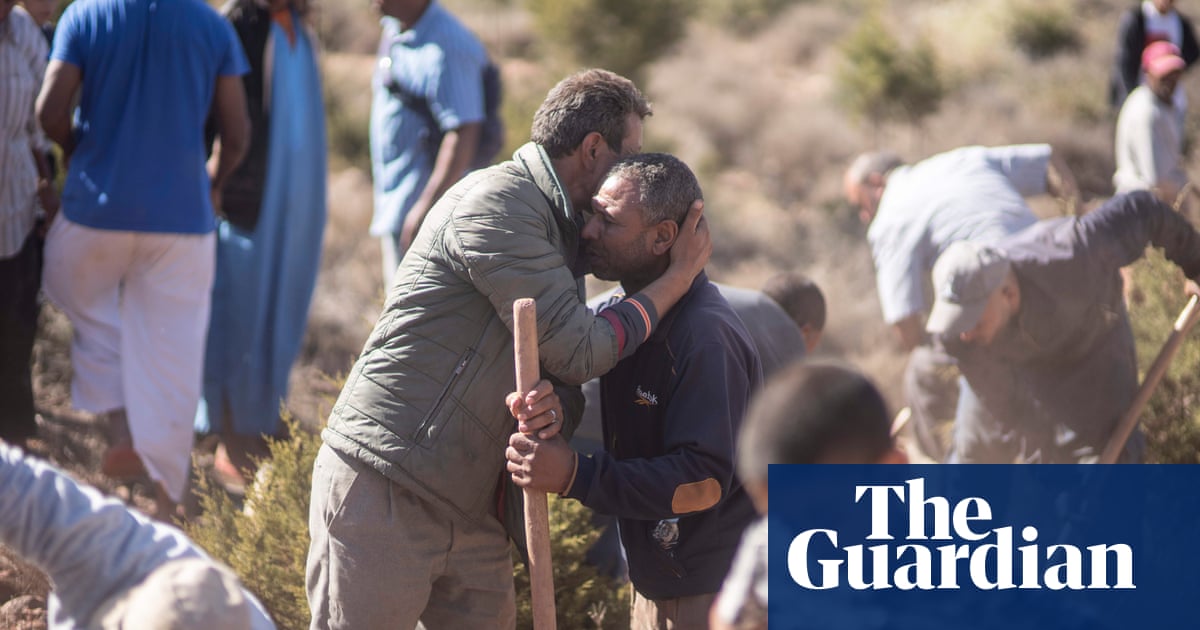
Earthquake rescue efforts have continued in Morocco as it mourned the victims of a disaster that killed more than 2,000 people, flattening buildings in cities and villages.
Friday’s 6.8-magnitude quake, Morocco’s strongest on record, struck 72km (45 miles) south-west of Marrakech, wiping out entire villages in rural areas.
The government reported at least 2,012 people were killed and more than 2,059 injured, many of them critically. Troops and emergency services scrambled to reach remote mountain villages where victims were feared trapped.
Morocco declared three days of mourning, during which the national flag would be flown at half mast, the royal court said. The Moroccan armed forces were deploying rescue teams to provide affected areas with clean drinking water, food, tents and blankets, it added. Several countries, including Israel, France, Spain, Italy and the US, offered aid.
Neighbouring Algeria, which has had rocky relations with Morocco, opened its airspace, which had been closed for two years, to flights carrying humanitarian aid and the injured.
Al-Haouz province, at the epicentre of the earthquake, suffered the most deaths with 1,293 followed by the province of Taroudant with 452.
“I’ve lost everything”, said Lahcen, a resident of the remote mountain village of Moulay Brahim, whose wife and four children were killed.
Rescue workers recovered the bodies of Lahcen’s three daughters from the rubble of what was once their home, while continuing to search for the bodies of his wife and son.
“I can’t do anything about it now, I just want to get away from the world and mourn.”
Bouchra, another Moulay Brahim resident, dried her tears with her scarf as she watched men digging graves to bury the victims.
“My cousin’s grandchildren are dead,” she said in a knotted voice.
“I saw the devastation of the earthquake live and I’m still shaking. It’s like a ball of fire that has swallowed up everything in its path. Everyone here has lost family, whether in our village or elsewhere in the region.”
The Red Cross warned that it could take years to repair the damage.
“It won’t be a matter of a week or two … We are counting on a response that will take months, if not years”, the organisation’s Middle East and north Africa director, Hossam Elsharkawi, said.
The village of Tafeghaghte, 60km south-west of Marrakech, was almost entirely destroyed, with the quake’s epicentre about 50km away. AFP journalists reported very few buildings still standing.
“Three of my grandchildren and their mother are dead,” said 72-year-old Omar Benhanna. “They’re still under the debris. It wasn’t so long ago that we were playing together.”
Residents buried about 70 victims in the nearby cemetery on Saturday, in funeral rites punctuated by cries and screams. In the evening, television channels broadcast aerial images showing entire villages of clay houses in the al-Haouz region completely destroyed.
Residents of Marrakech, the major city nearest to the epicentre, said some buildings had collapsed in the old city, a Unesco world heritage site. The city’s famous 12th-century Koutoubia mosque suffered damage, but the extent was not immediately clear.
Initial reports said part of a minaret that towered over Djemaa el-Fna, a market square and hub for visitors, had collapsed, injuring two people, before people fled to the open area of the square to seek safety.
Morocco’s geophysical centre said the quake struck in the Ighil area with a magnitude of 7.2. The US Geological Survey put the quake’s magnitude at 6.8 and said it was at a relatively shallow depth of 18.5km (11.5 miles).
Philippe Vernant – a specialist in active tectonics, particularly in Morocco, at the University of Montpellier – told Agence France-Presse that even though the quake did not hit in Morocco’s most active seismological region, aftershocks could be expected. “Even if they are less strong, they can lead to the collapse of buildings already weakened by the earthquake. Traditionally, we tend to say that aftershocks diminish in intensity.”
The tremor was also felt in the coastal cities of Rabat, Casablanca, Agadir and Essaouira, where many panicked residents took to the streets in the middle of the night, fearing that their homes would collapse.
The prime minister of Morocco’s cross-strait neighbour Spain, Pedro Sánchez, expressed his “solidarity and support to the people of Morocco in the wake of this terrible earthquake … Spain is with the victims of this tragedy.”
The French president, Emmanuel Macron, said he was “devastated” and that “France stands ready to help with first aid”.
Algerian state television broadcast a message from the presidency, declaring that the state would open its airspace to allow the transport of humanitarian aid to Morocco as well as offering aid resources, a significant shift after the complete rupture in diplomatic relations between the two nations that has lasted for two years.
This earthquake is the deadliest in Morocco since the 1960 quake that destroyed Agadir and killed 15,000 people, a third of the city’s population. In 1980, the 7.3-magnitude El Asnam earthquake in neighbouring Algeria killed 2,500 people and left at least 300,000 homeless.
Agence France-Presse, Reuters and Associated Press contributed to this report
https://news.google.com/rss/articles/CBMifmh0dHBzOi8vd3d3LnRoZWd1YXJkaWFuLmNvbS93b3JsZC8yMDIzL3NlcC8xMC9tb3JvY2NvLWVhcnRocXVha2UtbW91cm5pbmctYmVnaW5zLWFzLXJlc2N1ZS1jb250aW51ZXMtd2l0aC1kZWF0aC10b2xsLW92ZXItMjAwMNIBfmh0dHBzOi8vYW1wLnRoZWd1YXJkaWFuLmNvbS93b3JsZC8yMDIzL3NlcC8xMC9tb3JvY2NvLWVhcnRocXVha2UtbW91cm5pbmctYmVnaW5zLWFzLXJlc2N1ZS1jb250aW51ZXMtd2l0aC1kZWF0aC10b2xsLW92ZXItMjAwMA?oc=5
2023-09-10 07:12:00Z
2417420500
Tidak ada komentar:
Posting Komentar